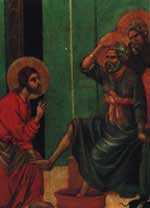| Tradition of foot washing Foot washing was commonplace in
ancient times, because the roads were dusty and
footwear expensive. Foot washing was therefore an
everyday ritual that was not considered a gesture
of devotion or even submission, but above all a
sign of respect and appreciation for the next
person. They served not only to cleanse but also
to heal and care for feet sore from long walks.
Jesus also expressed his respect for others and his humility by washing the feet of his twelve disciples the night before his death. He knew the importance of the feet, which are conventionally thought of as worthless and unclean, when he brought them into the centre of general attention. In the Catholic Church, the tradition of foot washing on Holy Thursday can be traced back to this biblical tradition. Even today, this ritual is offered to the faithful by the Pope, his cardinals and bishops as a symbolic gesture of humility. In the meantime, the ritual of foot washing has completely disappeared from people's everyday lives. Today, the idea of foot washing often arouses astonishment or alienation. And yet, in recent years, awareness of the importance of healthy and well-groomed feet for overall well-being has increased again with the knowledge of foot reflex zones and alternative medicine. The ritual foot washing ceremony revives this old tradition with all its symbolic meaning as an art performance/installation. |
 |
For more interesting aspects,
philosophical considerations and practical insights on
the topic, see:
interesting facts about feet
interesting facts about feet